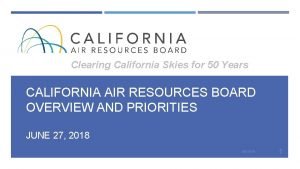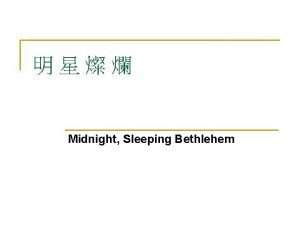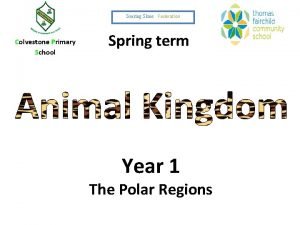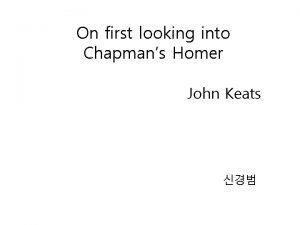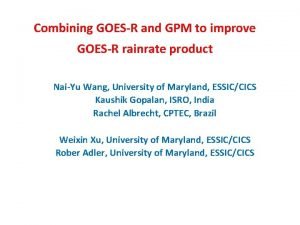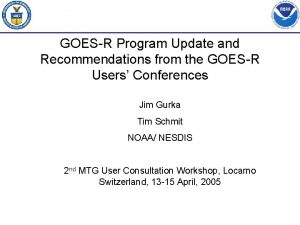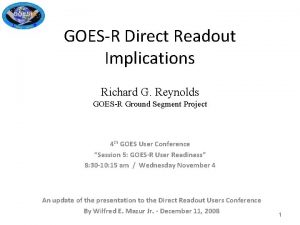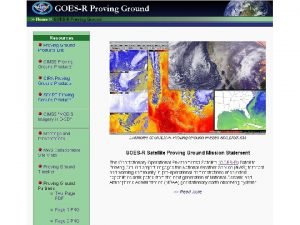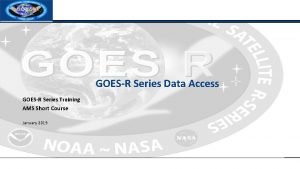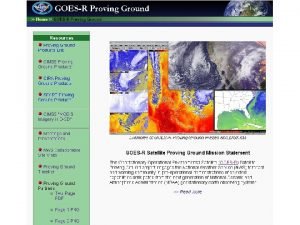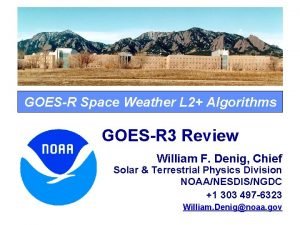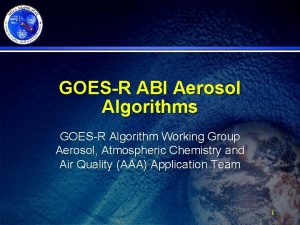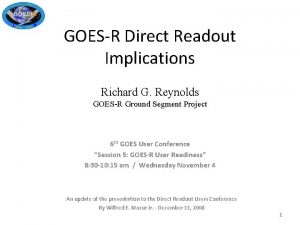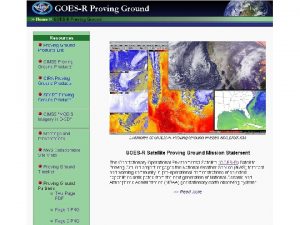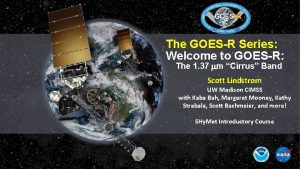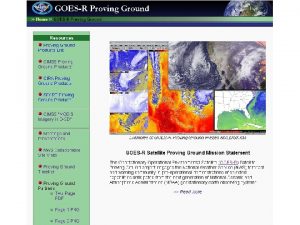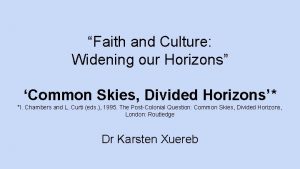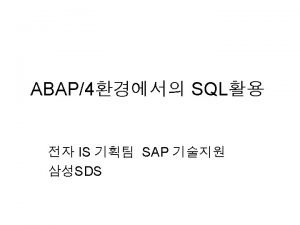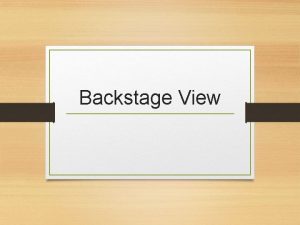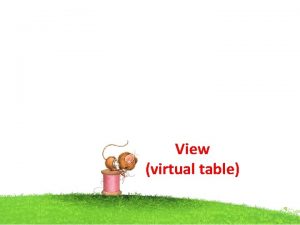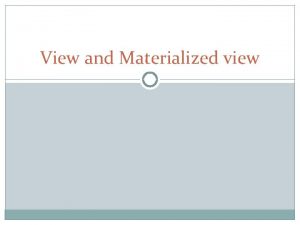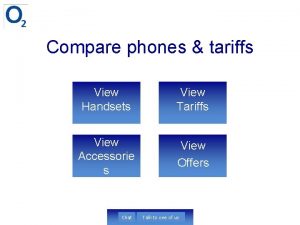A New View of Our Skies The GOESR



























- Slides: 27

A New View of Our Skies: The GOES-R Satellite Series in Action Eleanor Vallier-Talbot NOAA/National Weather Service Boston/Norton, MA

GOES 16/17 Instruments n Advanced Baseline Imager (ABI) – Primary instrument for processing imagery – Multichannel imaging radiometer – Cloud, Moisture, Particulate & Temperature data for wide variety of products n Geostationary Lightning Mapper (GLM) – Data captured in Events, Groups & Flashes

GOES 16/17 Instruments n Space Weather Instruments – Solar Ultraviolet Imager (SUVI) – Extreme Ultraviolet & X-Ray Irradiance sensors (EXIS) n SUVI & EXIS measure UV light & X-rays – Space Environment In-Situ Suite (SEISS) n Measures emission of Magnetosphere particles – Magnetometer (MAG) n Monitors sun’s geomagnetic field

GOES 16/17 Products n 16 Main Channels – 2 Visible – 4 Near Infrared (NIR) – 10 Infrared Two Channel Differences Imagery n Multispectral Red-Green-Blue Composites n – Simple and Advanced

GOES 16/17 Imagery n Visible – Red/Blue channels n Near IR – High clouds (Cirrus) – Vegetation (“Veggie”) – Snow/Ice n IR – Low, mid and upper tropospheric levels – Ozone – Cloud Top Phase – CO 2

Nor’easter – March 1 -3, 2018 GOES-East Visible Satellite imagery Highest Wind Gusts – 97 mph – Wellfleet, MA 95 mph – Chatham, MA 93 mph – Barnstable, MA

GOES-16 Infrared “Clean”

GOES 16 Geo. Color Day/Night Imagery Multispectral IR True Color “Visible at Night” Credit: GOES East Image Viewer https: //www. star. nesdis. noaa. gov/GOES/

Natural Color Images Credit: Scott Bachmeier @CIMSS_Satellite on Twitter GOES-East Red/Veggie Pseudo (Green/Blue Color) – 21 Sep 2018 –

GOES Two Channel Difference Products n n Based on Brightness Temperature Differences (BTD) Products – Split Window Difference (SWD) – 10. 3 µm - 12. 3 µm n Difference in Water Vapor absorption n Key absorption differences in airborne dust – 10. 7 µm - 3. 9 µm n Detects water based clouds at night, including fog/low stratus – 8. 6 µm – 10. 7 µm n Absorption differences in ice clouds

Credit: NOAA/NESDIS, VISIT, SHy. MET, CIRA, RAMMB Channel Difference Product n Split Window Difference – Used in Convective Initiation even before clouds develop (picks up boundary/convergence zone) – Identifies new convection that will eventually develop into mature thunderstorms n Convective case in Texas Panhandle 15 May 2018 – http: //rammb. cira. colostate. edu/templates/loop_directory. asp? data_folder=training/visit/loops/29 may 18/swd_4 panel&loop_speed_ms=60 Credit: Lindsay, Daniel, et al, BAMS – August 2018 Using the GOES-16 Split Window Difference to Detect a Boundary prior to Cloud Formation

Split Window Difference Product n n n Use Difference to see Increasing or Decreasing Atmospheric Moisture April 7, 2017 – South Central U. S. – High pressure shifts east to Mississippi Valley while weak trough moves across WY/CO into central Plains – NON severe weather day, shows increasing humidity http: //cimss. ssec. wisc. edu/goes/blog/wpcontent/uploads/2017/04/SWD_1430 UTC_07 Apr 2017_ with 850 Dewpoints_Defaults_toggle. gif

“Priming the Atmosphere” April 7, 2017 Credit: NWS/Storm Prediction Center and CIMSS Satellite Blog April 9, 2017

RBG Composites n Meteo. Sat developed sets of “recipes” (second generation) in the early 2000 s – Creates image data with specific wavelength ranges within electromagnetic spectrum – Blend of brightness temperatures and/or temperature differences n Qualitative false color images designed to enhance specific features: – – Low Clouds/Fog Atmospheric Dust Convection Air Mass Characteristics -- Fires/Hot Spots -- Smoke Plumes -- Snow/Ice – Volcanic Ash

RBG Composites n Applications – Cloud phase & height analysis – Distinguishing fog vs. low clouds – Identifying & tracking airborne objects such as volcanic ash, blowing dust, fire hot spots – Determine strong convection, jet streaks, ice content, moisture areas, etc.

“Simple” RBG Composite Simple Water Vapor Hurricane Florence 16 -Sep-2018 1557 UTC Credit: NASA SPo. RT

Air Mass RGB Inference of cyclogenesis n Used to diagnose environment around synoptic weather systems n – Enhanced air mass temperature/moisture characteristics Validate location(s) of potential vorticity anomalies in model data n Difficult to delineate difference in high heat situations (desert) n

Tropical Storm Gordon Credit: NASA SPo. RT Air Mass RGB Composite September 4, 2018 – 1847 UTC

Dust RGB n Difficult to see in Visible and Infrared Satellite imagery – Similar to other cloud types Uses band differencing and IR thermal channel to contrast airborne dust n Also uses particle phase, optical depth and cloud thickness especially in the Red color band to determine dust areas vs. clouds n

March 6, 2017 Credit: Kevin Fuell NASA SPo. RT

Day Convection RGB Identifies intense updrafts indicative of strong convection n Look for the YELLOW! Using the 3. 9 µm identifies small ice particles n – Particles don’t grow with intense updrafts n Differentiates between new and mature convection – Orange/Red = Dissipating convection – Yellow = Strengthening convection

Credit: Kris White/NWS Huntsville, AL Contribution to NASA/SPo. RT Application Library https: //weather. msfc. nasa. gov/spor t/training/App. Lib/1 min/Applib_1 mi n_SPo. RT_20170403_Dt. Conv. RGB_CO NUSESE_Svr. Strm. GA. pdf

Nighttime Microphysics RGB Distinction between low clouds/fog n Two channel differences used n – 10. 4 µm - 3. 9 µm and 12. 4 µm - 10. 4 µm Excellent delineation between cloud heights n Overnight cloud/fog show from New Credit: England on September 24 NASA SPo. RT n https: //twitter. com/NWSBoston/status/1044133171510554624

GOES-16/East Mesoscale Domain Sector (MDS) Preview One minute, movable 1000 km² satellite sectors Two sectors available from GOES 16 & 17 by local NWS WFOs Also available from GOES-17 (Change 16 to 17 in URL) http: //rammb. cira. colostate. edu/products/goes-16_mds_preview/

Hurricane Ophelia – October 16, 2017 Category 3 hurricane on October 14 across the eastern Atlantic before rapid extratropical transition n Development of a “sting jet” during transition as the storm moved across the United Kingdom and Ireland n Gust up to 103 knots reported (SW Ireland) n http: //cimss. ssec. wisc. edu/goes/blog/page/ 3? s=sting+jet n

Credits n NASA/NOAA GOES-R website – www. goes-r. gov n n Cooperative Institute for Meteorological Satellite Studies (CIMSS) NASA Short Term Prediction Research & Transition (SPo. RT) Center CIMMS Satellite Blog College of Du. Page NEXLAB Experimental Satellite – https: //weather. cod. edu/satrad/exper/

 Eisenhower apush
Eisenhower apush Clearing california skies
Clearing california skies To tame the perilous skies
To tame the perilous skies The peace not promised
The peace not promised Midnight stars make bright the skies
Midnight stars make bright the skies Soaring skies federation
Soaring skies federation Then felt i like some watcher of the skies
Then felt i like some watcher of the skies In a little basket under skies of blue
In a little basket under skies of blue Thinking language and intelligence
Thinking language and intelligence Our census our future
Our census our future Christ, be our light shine in our hearts
Christ, be our light shine in our hearts Marcus aurelius our life is what our thoughts make it
Marcus aurelius our life is what our thoughts make it We bow our hearts
We bow our hearts Our census our future
Our census our future Our life is what our thoughts make it
Our life is what our thoughts make it Money madness short summary
Money madness short summary Awareness of ourselves and our environment is:
Awareness of ourselves and our environment is: Awareness of ourselves and our environment
Awareness of ourselves and our environment God our father christ our brother
God our father christ our brother Our future is in our hands quotes
Our future is in our hands quotes Our awareness of ourselves and our environment.
Our awareness of ourselves and our environment. Awareness of ourselves and our environment is:
Awareness of ourselves and our environment is: Hình ảnh bộ gõ cơ thể búng tay
Hình ảnh bộ gõ cơ thể búng tay Slidetodoc
Slidetodoc Bổ thể
Bổ thể Tỉ lệ cơ thể trẻ em
Tỉ lệ cơ thể trẻ em Chó sói
Chó sói Tư thế worm breton
Tư thế worm breton

